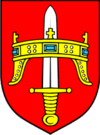Civljane
Civljane (Serbian Cyrillic: Цивљане)[3] is small village and a municipality in Šibenik-Knin County, Croatia. With only 239 inhabitants, it is the smallest municipality in Croatia by population.[4] Civljane is an underdeveloped municipality which is statistically classified as the First Category Area of Special State Concern by the Government of Croatia.[5]
Civljane | |
|---|---|
| Općina Civljane Civljane Municipality | |
 Civljane Location of Civljane in Croatia | |
| Coordinates: 43°57′N 16°24′E | |
| Country | |
| County | Šibenik-Knin |
| Government | |
| • Mayor | Ante Gutić (HDZ) |
| Area | |
| • Total | 82.78 km2 (31.96 sq mi) |
| Population (2011) | |
| • Total | 239 |
| • Settlement | 44 |
| Time zone | UTC+1 (CET) |
| • Summer (DST) | UTC+2 (CEST) |
| Website | www |
History
In the 9th century, probably during the time of Duke Branimir of Croatia, the Church of Holy Salvation (Crkva sv. Spasa) was built in Cetina, near Vrlika, then called Vrh Rike.[6] It is the only Croatian early medieval church with almost entirely preserved walls.[7]
The Orthodox Church of Holy Salvation on the spring of the Cetina River was built in 1940, founded by Marko Četnik and his wife Jelena. The church was rebuilt in 1974.
Population
As of 2011, there are 188 Serbs, making up 78.7% of the population, and 44 Croats, making up 19.7% of the population, and 7 others.[8] There are 216 Croatian speakers, and 4 Serbian speakers.[9]
According to the 2011 census, the municipality had 239 inhabitants, situated in two villages:[10]
- Cetina - 195
- Civljane - 44
The average age of residents is 71, making Civljane the oldest municipality in Croatia.[11]
Languages
Serbian Language, along with Serbian Cyrillic alphabet, is the second official language in the municipality alongside with the Croatian language which is official in the whole country.[12]
Geography
The municipality is located in the Dalmatian Hinterland, north of the town of Vrlika and Peruća Lake, on the field near the spring of Cetina River, on altitude of approximately 400 m, just under south base of mountain Dinara. The settlement of Civljane itself covers an area of 17.80 km2. Parts of the settlement are hamlets:
- Čitluk
- Dubrava pod Kozjakom
- Kotluša
- Kozjak
- Marjevci pod Kozjakom
See also
- Vrlika
- Glavaš - Dinarić Fortress
- Church of Holy Salvation
- Orthodox church of Holy Salvation
References
- Government of Croatia (October 2013). "Peto izvješće Republike Hrvatske o primjeni Europske povelje o regionalnim ili manjinskim jezicima" (PDF) (in Croatian). Council of Europe. p. 36. Retrieved 30 November 2016.
- "Općine na područjima posebne državne skrbi Republike Hrvatske" (PDF). Croatian Chamber of Economy. Retrieved 15 April 2020.
- "Registar Geografskih Imena Nacionalnih Manjina Republike Hrvatske" (PDF). Nipp.hr. Archived from the original (PDF) on 2013-10-29. Retrieved 2014-02-23.
- "Zanimljivosti iz popisa stanovništva" (in Croatian). 2 July 2011. Retrieved 8 March 2014.
- Lovrinčević, Željko; Davor, Mikulić; Budak, Jelena (June 2004). "AREAS OF SPECIAL STATE CONCERN IN CROATIA- REGIONAL DEVELOPMENT DIFFERENCES AND THE DEMOGRAPHIC AND EDUCATIONAL CHARACTERISTICS". Ekonomski pregled, Vol.55 No.5-6. Archived from the original on 18 August 2018. Retrieved 25 August 2018.
- "Srednji vijek". Public.carnet.hr. Retrieved 2014-02-23.
- http://www.hkv.hr/reportae/lj-krinjar/5655-reportaa-starohrvatska-crkva-svetog-spasa-na-izvoru-rijeke-cetine.html
- "Population by Ethnicity, by Towns/Municipalities, 2011 Census: County of Šibenik-Knin". Census of Population, Households and Dwellings 2011. Zagreb: Croatian Bureau of Statistics. December 2012.
- "Population by Mother Tongue, by Towns/Municipalities, 2011 Census: County of Šibenik-Knin". Census of Population, Households and Dwellings 2011. Zagreb: Croatian Bureau of Statistics. December 2012.
- "Population by Age and Sex, by Settlements, 2011 Census: Civljane". Census of Population, Households and Dwellings 2011. Zagreb: Croatian Bureau of Statistics. December 2012.
- "Pogledajte gdje u Hrvatskoj žive stari, a gdje mladi". Večernji list (in Croatian). 5 January 2014. Retrieved 25 November 2016.
- Izvješće o provođenju ustavnog zakona o pravima nacionalnih manjina i o utošku sredstava osiguranih u državnom proračunu Republike Hrvatske za 2008. godinu za potrebe nacionalnih manjina, Zagreb, 2009.
